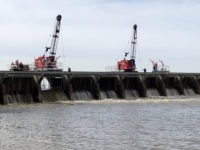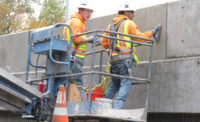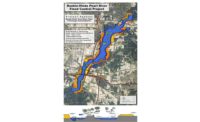Workers building the $409-million John James Audubon Bridge over the Mississippi River in Louisiana will have to complete construction with cars cruising by, after the contractor complied with a state request to open the bridge more than a month early to help the state cope with high river levels that shut down an alternative crossing.

With speechmaking and a slow-moving parade of drivers taking advantage of the unexpected chance to try out the giant new bridge—the longest cable stayed in western hemisphere—the Louisiana Dept. of Transportation and Development hosted an emergency opening on May 5, when high water triggered a halt ferry service between St. Francisville and New Roads, where the bridge is located.
The ferry was to shut down permanently when the bridge opened, but not until mid-June, says Stephen Spohrer, deputy director, construction, Louisiana TIMED Managers, which is performing construction management for La. DOTD. “The early opening will be an inconvenience to us and the contractor, but we accelerated for convenience to the public,” he said.
“Since this is an emergency situation, we’ve talked to the contractor and determined that it’s 100% safe to allow traffic on the bridge at this time,” says Sherri H. LeBas, Secretary of the La. DOTD.
But the early opening means Audubon Bridge Constructors, a joint venture of Flatiron Constructors, Inc., Longmont, Col., Granite Construction, Watsonville, Calif., and Parsons Transportation Group Inc., Washington, D.C., will have to work within the shoulder lane to complete details of the anti-vandalism devices on the main span’s cable stays, Spohrer says.
Other remaining work includes painting, some electrical work in the H-pylon towers and commissioning of a traveler device beneath the deck for inspection and maintenance.
The early opening won’t impact ABC’s work too much, says Sarah Tacker, deputy project manager for the joint venture. However, high river levels will delay the dismantling of a +54-ft trestle that ABC designed to provide access to some parts of the project during periods of high water.
The bridge is the central feature of a project that also includes 12 miles of new approach roadways, connecting U.S. 61 to La. 1. Because the approaches also weren’t opened until May 5, most people had not seen the bridge previously, Spohrer says. “It’s a big deal because now we can share the magnificence of it, the incredible engineering and high-quality construction, with the public.”
The project is one of 16 in the Transportation Infrastructure Model for Economic Development program, designed to enhance economic development in Louisiana through transportation investment. “The citizens voted for this four-cents-per-gallon tax in 1989, and they have expectations for delivery,” says Richard Savoie, La. DOTD chief engineer. “It’s a beautiful bridge, and it will open up commerce on both sides of the river. Citizens will be able to cross the bridge in any weather and with any river levels.”



